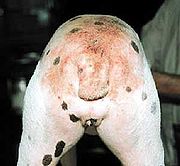
Flea allergy dermatitis
Encyclopedia
Flea allergy dermatitis is an eczematous itchy skin disease of dogs and cats.  For both of these domestic species flea allergy dermatitis is the most common cause of skin disease. Affected animals develop allergic reactions to chemicals in flea saliva. Symptoms of this reaction include erythema (redness), papules (bumps), pustules (pus-filled bumps), crusts (scabs) also if severe, hair loss will occur in affected area . Dogs with flea allergy dermatitis often show hair loss and eczema
For both of these domestic species flea allergy dermatitis is the most common cause of skin disease. Affected animals develop allergic reactions to chemicals in flea saliva. Symptoms of this reaction include erythema (redness), papules (bumps), pustules (pus-filled bumps), crusts (scabs) also if severe, hair loss will occur in affected area . Dogs with flea allergy dermatitis often show hair loss and eczema
tous skin rash on the lower back, upper tail, neck and down the back of the legs. Cats with flea allergy dermatitis may develop a variety of skin problems, including feline eosinophilic granuloma
, miliary dermatitis
or self-inflicted alopecia
from excessive grooming.

Eczema
Eczema is a form of dermatitis, or inflammation of the epidermis . In England, an estimated 5.7 million or about one in every nine people have been diagnosed with the disease by a clinician at some point in their lives.The term eczema is broadly applied to a range of persistent skin conditions...
tous skin rash on the lower back, upper tail, neck and down the back of the legs. Cats with flea allergy dermatitis may develop a variety of skin problems, including feline eosinophilic granuloma
Feline eosinophilic granuloma
Eosinophilic granuloma is a form of Langerhans cell histiocytosis.It is a condition of both human and veterinary pathology.Feline eosinophilic granuloma complex is synonymous with feline eosinophilic skin diseases. This is considered to be a cutaneous reaction pattern that can be the manifestation...
, miliary dermatitis
Miliary dermatitis
Miliary dermatitis is a descriptive term used in veterinary medicine to describe a multifocal distribution of skin lesions, with no identifiable pattern...
or self-inflicted alopecia
Alopecia
Alopecia means loss of hair from the head or body. Alopecia can mean baldness, a term generally reserved for pattern alopecia or androgenic alopecia. Compulsive pulling of hair can also produce hair loss. Hairstyling routines such as tight ponytails or braids may induce Traction alopecia. Both...
from excessive grooming.

